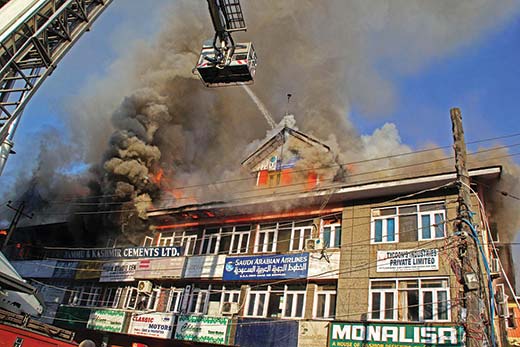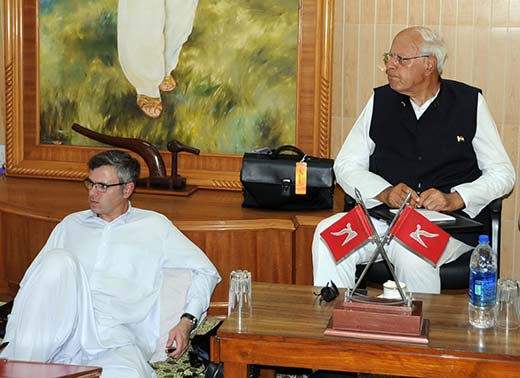Last fortnight, NC headquarter survived a conflagration. Bilal Handoo revisits the party’s history revolving round its headquarters that shifted from one bank of the river in Mujahid Manzil to another in uptown

It may take some time more but the headquarters of National Conference (NC) is still recovering from the impact of deluge it witnessed in September 2014. Located at banks of Jhelum near Srinagar’s Zero Bridge, Nawa-ie-Subah or the new morning looks ‘misty’ at the moment. Though the flood-drenched party flags—bearing white plough on red cloth, have sun-dried, the stock is wet again. This time, the fire fighters water was the culprit.
Post-defeat, this building was epicenter of some of the major introspections of the party. Its bigwigs tasted lot of criticism as irked workers castigated them for mishandling the ‘party of plough’. At one point of time, the party leaders stopped coming to this building and instead started interactions at G-8, the home of Omar, its working president.
Dr Farooq Abdullah is yet to visit the building after his return from London. But that does not make Nawa-ie-Subh an unimportant construction. It, however, is less important and less interesting than Mujahid Mazil, the main headquarters of the party. Nawa-ie-Subh, it may be recalled here, owes its name to the printing press and the newspaper that would come out daily and its name was Nawa-ie-Subh. The newspaper that would go free to all the sarpanches once upon a time has ceased to exist for a long time now.
Old City’s MM remained hotbed of Kashmir politics for around seven decades. It also served as NC headquarters till 1994 when the structure was torched by ‘suspected militants’—forcing NC to shift its headquarters to Zero Bridge complex in the secured uptown.
Two years after shifting from old city to uptown, NC had their ‘much’ relieved moment. It was 1996, and New Delhi had finally convinced a ‘runaway’ Farooq Abdullah to return to state politics. (Abdullah had fled to England in 1989 after arms struggle broke out in valley. But before leaving, he dropped one last message for his supporters: “If you have someone in mind who ends up in jail, you can count me out. I like to play golf. What am I going to do in jail?”)
NC eventually won 1996 polls by an overwhelming majority—winning 57 of total 87 assembly seats. And soon the flamboyant son of Sheikh Abdullah became fourth time chief minister of state.
That victory was indeed a big moment for NC, says Dr Mustafa Kamal: “It marked the return of an elected government to state.” Besides, he says, the poll victory boosted the morale of NC workers—“thousands of whom were slaughtered, eliminated and intimidated”.
But the years that followed, it is said: mostly cheerless faces reigned supreme inside Nawa-ie-Subh than cheerful. When Vajpayee government discarded NC’s political cry—Autonomy, the mood inside the complex turned militant. And when third generation Abdullah lost his family seat from Ganderbal in 2002, a pall of gloom descended over there—leaving Farooq Abdullah visibly crestfallen with his hands on his head.
Omar Abdullah’s defeat against PDP’s Qazi Afzal was the first defeat for Abdullahs since their return to state politics in 1975. The defeat meant that for the first time, no Abdullah would be sitting inside state assembly since Sheikh signed the accord in mid-seventies.
This and more was happening inside the Nawa-ie-Subh complex —until 2008.
At the fag end of that year, people fell in lines on the streets, simmering against establishment a month before polls. To cash the sentiments, Omar Abdullah—who had gained ‘sympathy’ after his ‘roaring’ speech inside Indian Parliament against Amarnath land lease, was seen apologising people of Ganderbal for his party’s past performance. With moist eyes he promised what many now call “moon” in exchange of votes.
When results were out, this building burst into celebrations. “The party had to wait for that moment for a very long time,” continues Dr Kamal. “It was a big relief for all of us.”
And thus began an ‘epic’ rule of Omar Abdullah—that witnessed a twin murders of 2009 in Shopian, a mayhem of 2010, a PSA spank, an APSPA rant, the Wikileak’s torture expose’, a murder of Haji…
All these incidents had their impact with NC’s oldies-cum-loyals visiting Nawa-ie-Subh complex to convey their displeasure over governance. “I visited Nawa-ie-Subh multiple times with a barrage of grievances,” says GA Saloora, a former senior NC leader from Ganderbal. “But I was told: ‘Saloora, stop interfering in constituency matters.’ ” In protest, Saloora parted his ways with NC, claiming: “Omar is shrugging off old NC workers to keep the new lots in good humour.”
Still gripped with political torrent, NC headquarters figured in PDD’s defaulters list in February 2013, owing Rs 7.80 lakh electricity charges to power department. But the embarrassing revelation for then ruling party died an anonymous death amid political din.
Nine months later, NC redefined its history when it heartily hosted some leaders of state Congress (a party once despised by NC and its cadres in Kashmir) inside Nawa-ie-Subh. It was for the first time that any Congress leader has stepped into Nawa-ie-Subh complex to a rousing reception. “You can call it the outcome of Rahul-Omar bonhomie,” Ali Mohammad Sagar later quipped.
A month after his defeat in parliamentary polls, Farooq Abdullah frequented Nawa-ie-Subh —chairing meetings and invoking confidence in his cadre-based party. In one such meeting, he appointed Ali Mohammad Sagar as NC’s new General Secretary (GS), saying former GS Sheikh Nazir’s health doesn’t allow him to continue. Sagar’s appointment was an attempt to “consolidate” the enviable organizational strength of the party.
Soon Abdullah was advocating a general amnesty for stone-pelters. His son’s sarkaar had rounded up around 600 youth in the run up to parliamentary polls in 2014, official figures reveal. Besides, over 1,300 youth across valley face charges of “rioting and stone pelting” since 2010.
And then suddenly the defeated Abdullah roared in his ‘den’: “Jis Kashmir Ko Khoon Se Seencha Woh Kashmir Humara Hai.” In that ‘adrenalin rush’ moment, he told his party men inside Nawa-ie-Subh that those who think that one poll debacle will dampen NC’s spirits should take a look at the pages of history: “Our spirits were not dampened when they sent Sheikh Sahib to prison for 24 years… Our spirits were not dampened when thousands of NC workers and hundreds of our leaders were killed in cold-blood…”
Abdullah’s speech had apparently pumped up his audience. Meanwhile, he continued: “We will rise from the ashes by scripting a comeback.” In that very speech he termed PDP patron Mufti Mohammad Sayeed as trusted lieutenant of Sadiq—“who sold the special status of J&K to New Delhi”.
But unlike Nawa-ie-Subh, NC’s history linked with Mujahid Mazil is often termed glorious than chequered. Manzil has been the cradle of NC’s politics since its foundation. Right from Sheikh Abdullah led ‘Quit Kashmir’ movement against the Dogra Maharaja to the launch of Plebiscite Front to the demands of right to self-determination by Kashmiris, the Manzil always aided NC’s growth.
After Moulana Masoodi, Sheikh Abdullah and others collected door-to-door funds, the Manzil or the house of mujahids was built with Rs 2300 in 1933. And soon it became a political bastion of Muslim Conference with Saleh Khan its custodian and Moulana Masoodi its supervisor.
With the Manzil as the living structure, an ordinary Kashmiri—then bearing the brunt of Dogra oppression had suddenly found a platform to raise the voice against the slavery and tyranny. Apart from people, Hurriyat leader Syed Ali Geelani and Jama’at leader Qari Saif-u-Din sung songs of freedom along with Sheikh Abdullah, Chowdary Ghulam Abbas and Mirwaiz Yusuf Shah.
But after Muslim Conference was named National Conference in 1939, the Manzil became default NC bastion, besides legacy.
 The stalwart leader of sub-continent Mohammed Ali Jinnah visited the Manzil before the partition seeking Kashmir’s merger with Pakistan. Nehru also came here after Jinnah to convince Sheikh that his destiny lay with a secular India. Mahatma Gandhi too visited it (on August 2, 1947) with his own “mission” followed by other “emissaries” including Maulana Abul Kalam Azad, Abdul Gaffar Khan and other front-ranking leaders of India’s freedom struggle.
The stalwart leader of sub-continent Mohammed Ali Jinnah visited the Manzil before the partition seeking Kashmir’s merger with Pakistan. Nehru also came here after Jinnah to convince Sheikh that his destiny lay with a secular India. Mahatma Gandhi too visited it (on August 2, 1947) with his own “mission” followed by other “emissaries” including Maulana Abul Kalam Azad, Abdul Gaffar Khan and other front-ranking leaders of India’s freedom struggle.
It was from the Manzil that the people of Jammu and Kashmir fought against autocratic rule in 1940s. Recorded events even claim: when Pakistan came into existence in 1947, Pakistani national flag was unfurled on the Manzil for some time.
But inside the Manzil where Sheikh Abdullah opposed Pakistan by calling for democracy in Kashmir and subsequently helped the state accede to India. And this is where his son Farooq Abdullah came to protest against New Delhi’s “excesses” after his government was toppled in 1984.
Geelani once termed the Manzil as ‘a legacy of Kashmiri Martyrs’. The annual July 13 procession on Martyrs Day in the memory of 1931 martyrs was traditionally taken out by NC from the Manzil. However, after Sheikh Abdullah signed accord in 1975, there was a division in the political leadership following which many people say, NC lost the moral authority to own the place.
In early 90s, when Kashmir was under Governor’s rule, militants operated from the Manzil for some time. And with majority losing faith in NC, this historic building bore the brunt. The three-storied stone and timber structure of MM was gutted soon after taken over by paramilitary forces. The blazing fire devoured important letters, documents and photographs of a contentious phase of Kashmiri history along with Abdullah’s desk and Nehru’s chair.
Presently NC’s past glory has been reduced into a half-burnt wooden structure (with smoked walls), and is occupied by paramilitary forces.
“My father used to listen people’s grievances at Mujahid Manzil after every Friday prayers,” Farooq Abdullah once said. “I want to revive the process.” In the summer of 2012, Omar Abdullah echoed the same wish: “It is my wish that we have Friday meetings again at Mujahid Manzil where Sheikh Sahib initiated this culture into our party.” But the father-son duo couldn’t move beyond lip-service to resume Sheikh’s aura at the Manzil.
With the Mazil gutted and Nawa-ie-Subh sombre, NC appears “off-colour”, especially after it lost power in 2014. Perhaps disobeying elder’s advice had its costs—“people’s hearts can be won only by love, justice, truthfulness and sincerity,” Omar apparently didn’t heed to this ‘last testament’ of his grandpa during his six years rule over state—“and not with subsidized rice, army and offering largesse.”
But there is no irrelevance in politics. Omar Abdullah recently celebrated the “failure” of the PDP-BJP coalition’s first 100 days. He says he is not unhappy over the results. “You guys gave me seven seats and I got 15,” he said. “And I see a different Mufti than I knew in 2002.” He, however, did not tell that his vote-bank is by and large unchanged. Whether or not the party will ever revive its old city roots, it definitely is not going to disappear from Kashmir politics.















